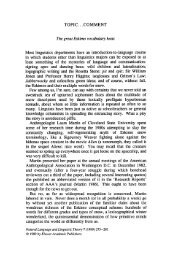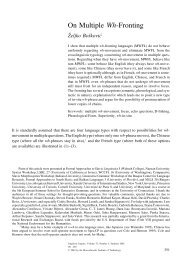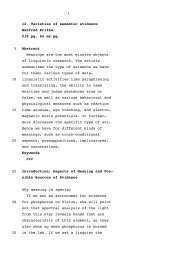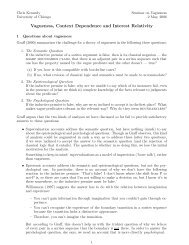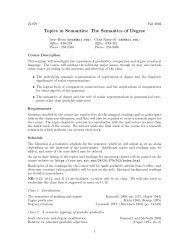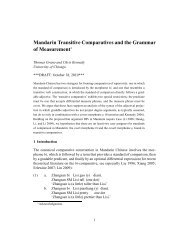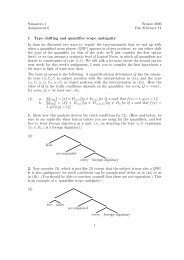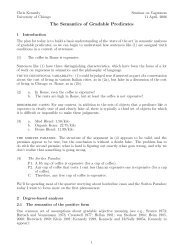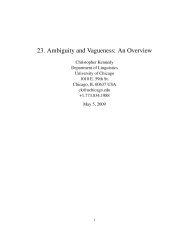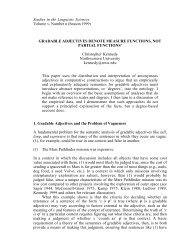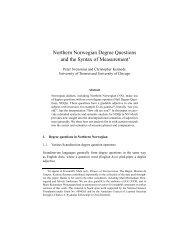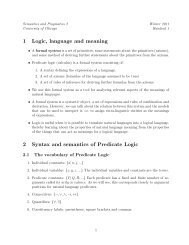On the natural history of negative polarity items - Syntax, Semantics ...
On the natural history of negative polarity items - Syntax, Semantics ...
On the natural history of negative polarity items - Syntax, Semantics ...
You also want an ePaper? Increase the reach of your titles
YUMPU automatically turns print PDFs into web optimized ePapers that Google loves.
Dongsik Lim & Chungmin Lee<br />
semantics <strong>of</strong> questions (Karttunen 1977, i.a.), a question denotes a set <strong>of</strong> answers, meaning that<br />
<strong>the</strong> entire question is uttered by <strong>the</strong> questioner, but <strong>the</strong> assertion is ‘delayed’ until <strong>the</strong> addressee<br />
picks up one <strong>of</strong> <strong>the</strong> answers as a true answer in <strong>the</strong> context. Similarly, <strong>the</strong> asserter <strong>of</strong> <strong>the</strong><br />
proposition that John went home in (2) is different from <strong>the</strong> utterer <strong>of</strong> <strong>the</strong> sentence, who simply<br />
‘delivers’ what she heard by uttering <strong>the</strong> sentence with <strong>the</strong> reportative evidential -lay.<br />
Given this, similarly to McCready’s (2006) propsal, we propose that Korean evidentials<br />
introduce a kind <strong>of</strong> context-shifting operator (Anand and Nevins 2004), which only changes <strong>the</strong><br />
asserter <strong>of</strong> <strong>the</strong> sentence to <strong>the</strong> evidence holder salient in <strong>the</strong> context. This can be formalized as<br />
(5), where OP is an operator introduced by an evidential marker (ei<strong>the</strong>r direct or indirect), ! is<br />
<strong>the</strong> prejacent, a is <strong>the</strong> asserter <strong>of</strong> !, and e is <strong>the</strong> evidence holder salient in <strong>the</strong> context:<br />
(5) Op ([[!]] ) = [[!]] <br />
In <strong>the</strong> declarative like (1a), since <strong>the</strong> evidential marker is direct, <strong>the</strong> evidence holder is <strong>the</strong><br />
asserter, which is also <strong>the</strong> utterer, hence no shift, even though <strong>the</strong> operator in (5) is introduced in<br />
(1a). In <strong>the</strong> question (1b), <strong>the</strong> contextually salient evidence holder can be <strong>the</strong> addressee, and<br />
<strong>the</strong>refore <strong>the</strong> operator can ‘overwrite’ <strong>the</strong> asserter <strong>of</strong> <strong>the</strong> answer as <strong>the</strong> addressee, and <strong>the</strong>refore,<br />
<strong>the</strong> addressee can be regarded as <strong>the</strong> evidence holder <strong>of</strong> each answer in <strong>the</strong> question. Finally, in<br />
cases like (2), <strong>the</strong> prejacent <strong>of</strong> -lay contains <strong>the</strong> direct evidential -te-, and <strong>the</strong>n <strong>the</strong> asserter <strong>of</strong> <strong>the</strong><br />
prejacent is ‘overwritten’ as <strong>the</strong> evidence holder, from whom <strong>the</strong> utterer <strong>of</strong> (2) has <strong>the</strong> reportative<br />
evidence.<br />
This proposal, which adopts <strong>the</strong> notion <strong>of</strong> <strong>the</strong> context shifting operator, gives us a way to<br />
account for <strong>the</strong> puzzle regarding Korean de se anaphor caki pointed out by Lim (2011).<br />
According to him, when -te- is used, <strong>the</strong> long-distance de se anaphor caki can refer to <strong>the</strong> attitude<br />
holder even when <strong>the</strong> attitude holder does not have <strong>the</strong> relevant de se knowledge, such as in (6):<br />
(6) (Scenario: Bill and John are close friends to each o<strong>the</strong>r. Their children are also close<br />
friends to each o<strong>the</strong>r, and go to <strong>the</strong> same school. <strong>On</strong>ce Bill and John were invited to <strong>the</strong><br />
school. In <strong>the</strong> school, when both Bill and John were looking at a class in a distance, <strong>the</strong>y<br />
saw one kid making troubles during a class. Later Bill came to Tom, <strong>the</strong> teacher, and told<br />
him to scold <strong>the</strong> kid who was making troubles in <strong>the</strong> class. However, John also found that,<br />
unbeknownst to Bill, <strong>the</strong> kid was actually Bill’s Son. Later John said…)<br />
Billi -i Tom-eykey cakii atul-ul honnay-la-ko ha-te-la.<br />
Bill-Nom Tom-Dat self son-Acc scold-Imp-Comp say-Dir.evi-Decl<br />
(intended) ‘Billi told Tom to scold selfi ’s son’ (with evidential implication)<br />
This can be accounted for if we regard Bill as <strong>the</strong> asserter <strong>of</strong> <strong>the</strong> embedded sentence, and -te-<br />
‘overwrites’ <strong>the</strong> asserter <strong>of</strong> <strong>the</strong> embedded proposition with <strong>the</strong> evidence holder, who is John <strong>the</strong><br />
speaker. Since John actually has <strong>the</strong> relevant knowledge regarding <strong>the</strong> relation between Bill and<br />
caki, and by <strong>the</strong> operator introduced by -te- John can be regarded as <strong>the</strong> asserter <strong>of</strong> <strong>the</strong> embedded<br />
proposition, we can assume that <strong>the</strong> relevant de se knowledge is provided by <strong>the</strong> evidence holder<br />
(<strong>the</strong> utterer), and <strong>the</strong>refore caki is licensed.<br />
References. ANAND, P. & NEVINS, A. 2004. Shifty operators in changing contexts. In Proc. <strong>of</strong><br />
SALT 14. KAPLAN, D. 1989. Demonstratives. In Themes from Kaplan. OUP. KARTTUNEN, L.<br />
1977. The syntax and semantics <strong>of</strong> questions. L&P 1. LEE, C. 2011. Evidentials: interactions and<br />
perspective shifts in Korean. Paper presented in ESSLLI 2011. LEE, J. 2011. Evidentiality and its<br />
interaction with tense. PhD Thesis, OSU. LIM, D. 2010. Evidentials and Interrogatives. PhD<br />
Thesis, USC. LIM, D. 2011. Temporal and inferential interpretation <strong>of</strong> Korean direct evidential -<br />
te-. To appear in Proc. <strong>of</strong> CLS 47. MCCREADY, E. 2006. Context shifting in questions and<br />
elsewhere. In Proc. <strong>of</strong> SuB 11.



